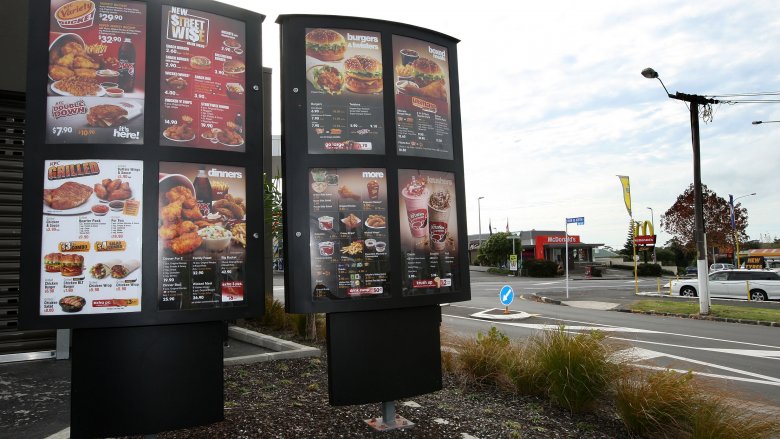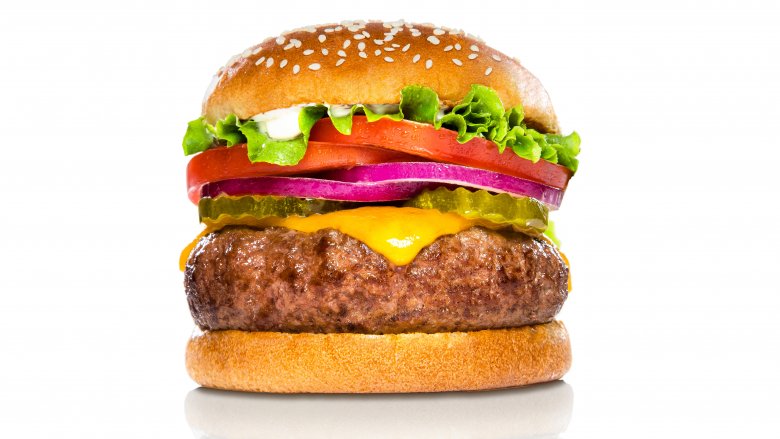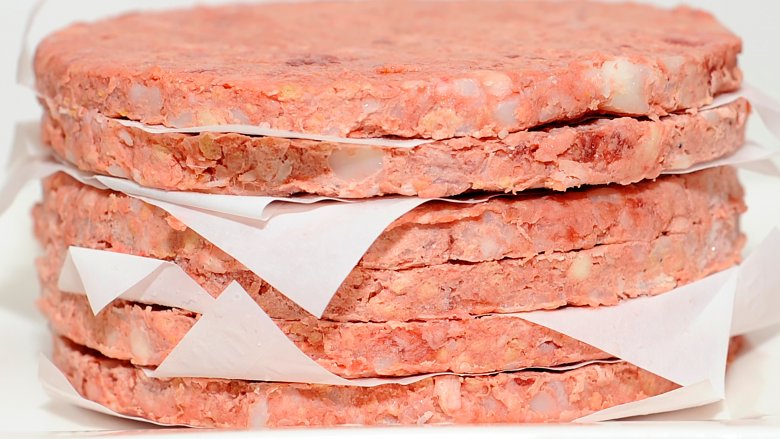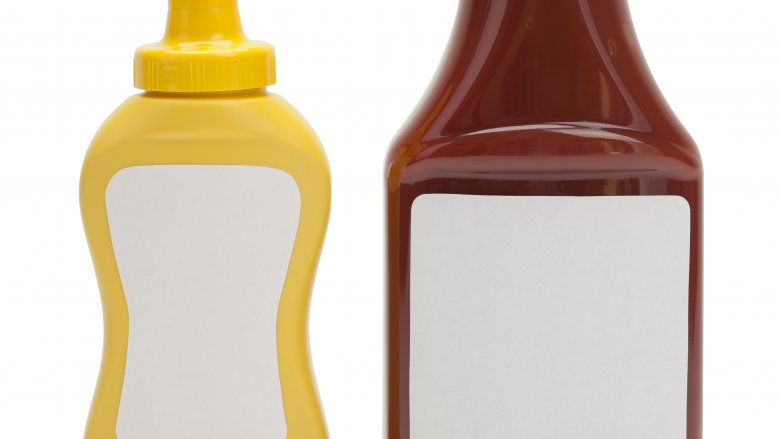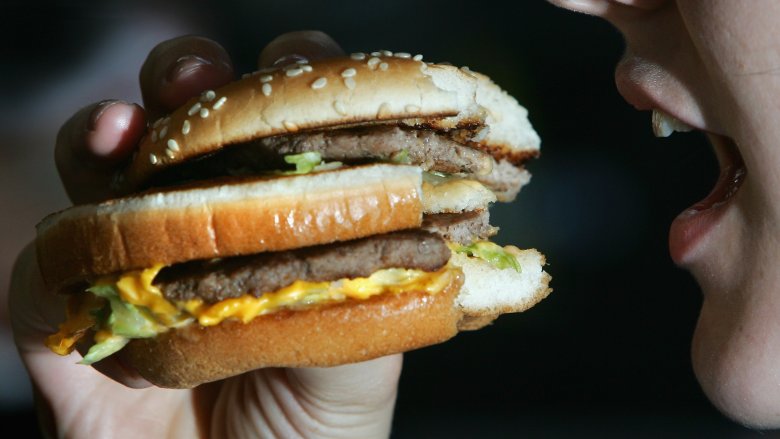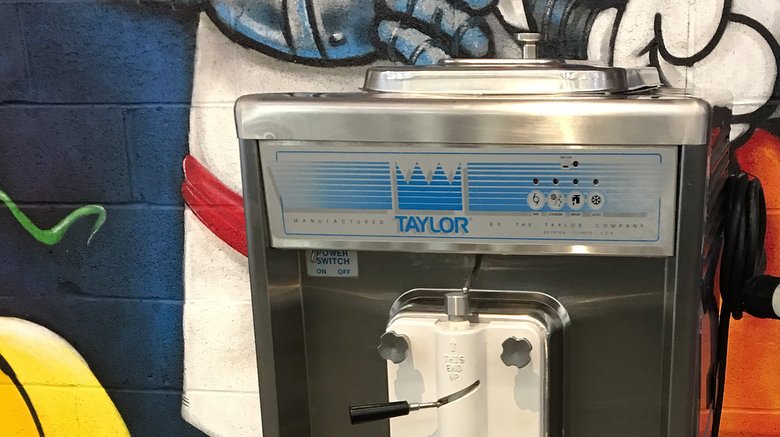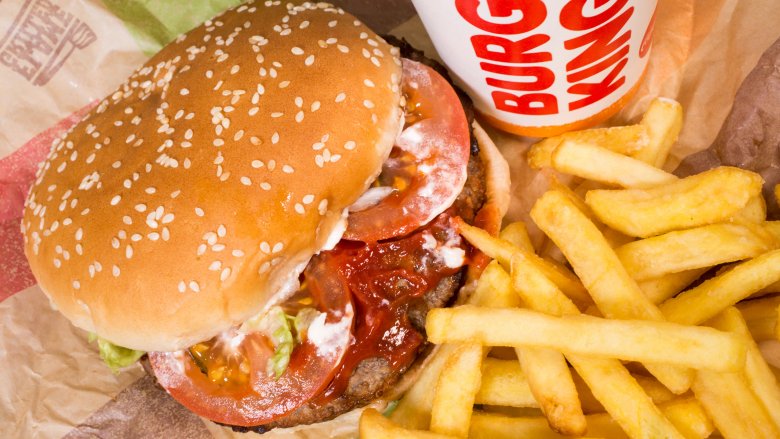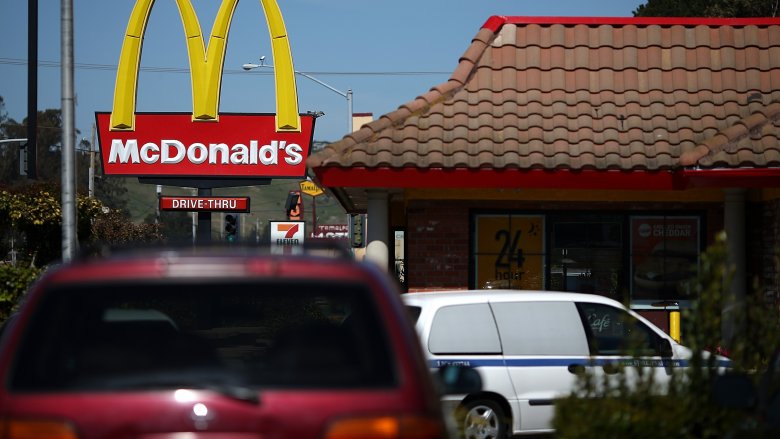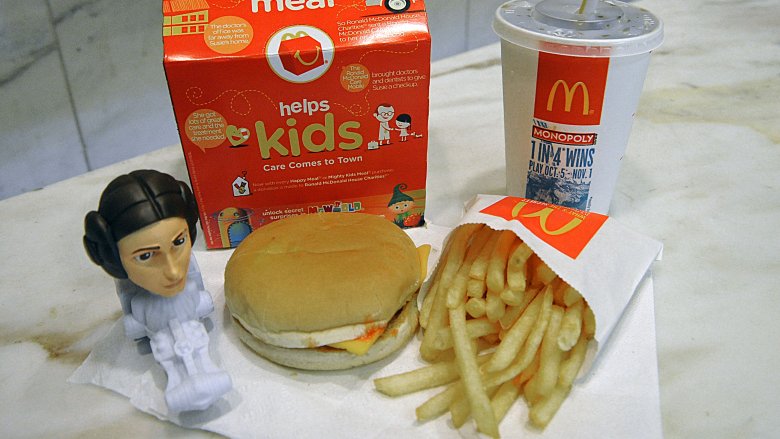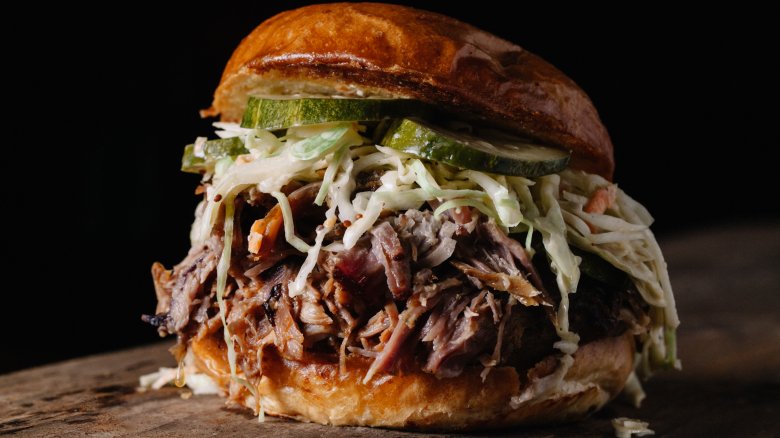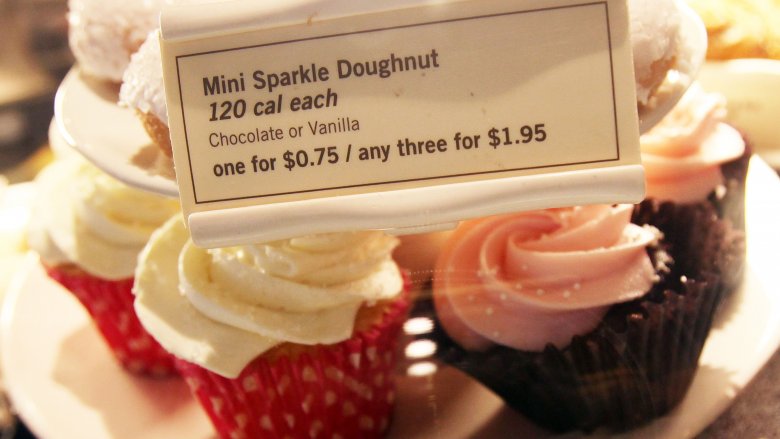Signs You're At A Bad Fast Food Restaurant
It happens to all of us, from time to time. You stop in at a fast food joint for some quick-service, inexpensive midday grub, looking forward to a meal that will provide a full day's worth of fat and calories at less than five bucks. But suddenly, as you're sitting at your red plastic table covered in crumbs, it starts to hit you: Something is off about this place.
Maybe you're sitting in a national chain location, like McDonald's or Burger King, that's fallen on hard times and is being run by a skeleton crew staff serving semi-expired product. Or maybe you're in one of our country's "also-ran" fast food places, those lesser-known strings of just a few hundred (or dozen) locations that may be doing their best, but for whatever reason, aren't able to capture the hearts (and stomachs) of a larger audience. Or maybe it's a mom-and-pop joint that has cheap food and a big menu board with pictures on it, but that has never managed to expand beyond one or two locations.
To help you navigate that vague sense of dread you may be feeling while you wait for your order number to be called, we've prepared a list of ways to help you identify the terrible truth you are facing: You may just be sitting in a bad fast food restaurant.
The pictures on the menu look like they were shot on a phone…
...and we don't even mean a GOOD phone. We're talking grainy, blurry flip-phone photos — those grainy, pixelated 256 color photos that look like they were transmissions sent from space back to mission control in the 1960s.
Even when the technical photo quality is okay, there may be other issues, thanks to some owner or manager deciding they were going to save a few bucks by shooting their food photos themselves. Harsh shadows. Weird yellow or blue light. Unappealing close-ups that magnify the least appetizing quality of the dish, such as the way bright orange grease pools around the base of a chunk of sweaty pork roast, or the uncooked jarred chopped garlic you've unceremoniously scooped onto a dish of wet, pasty-looking fish. Or worse, photos with no proper lighting at all, as though the meal was served to a small child trapped at the bottom of a well. At sunset. In December.
Look, there are plenty of ways to cut corners and save a few dollars when you're figuring out how to market your business. But the first impression that customers have of your food when they're looking at your menu isn't one of them. A fast food place that has such misplaced priorities probably isn't the place to trust with your dining dollars
The pictures on the menu are clearly stock photos
Sometimes, the trouble with the photos on the menu isn't that they're bad... it's that they're good. As in, too good. White backgrounds, studio lighting, and artfully arranged garnishes at the local hole-in-the-wall $2 falafel joint? Mysterious extra ingredients in that stir fry photo that don't seem to be listed on the menu's description of the dish? Chances are, you're looking at stock photography that may have little or nothing to do with the food you'll actually be served.
One of the most egregious examples of this we've seen was at a mall food court, that had just opened up a new off-brand Greek-style gyro place. Everything seemed legit: Big vertical rotisseries stabbed through with huge chunks of crisping lamb, warm pita, house-made tzatziki. And then, displayed on a big electronic sign hanging over the heads of the employees: A photo of a huge, overstuffed chicken wrap, hanging suspended in space, with massive chunks of perfectly bronzed, seasoned chicken breast, cascades of shredded lettuce leaping off the screen in celebration, dotted with artful pockets of creamy sauce oozing out of fluffy, picture-perfect pita. And then the kicker: A massive stock photo watermark, laid over the top of the whole thing.
The takeaway? If a fast food place isn't showing you photos of what you're actually going to be served, turn and run the other way.
The tables and/or bathrooms are dirty
Soda-spattered, crumb-covered tables are certainly enough to give you the heebie-jeebies, and a messy or dirty bathroom is gross on a whole lot of levels, but it's not the practical parts of these symptoms of a bad fast food restaurant that bother us. As much as paper-soaked paper towels sliming up the mirror, or a thin layer of someone else's toilet paper lining the seat in the stall may be off-putting, it's symptomatic of a much bigger problem: An inattention to detail and a lack of basic upkeep.
See, a sticky table (or for that matter, a sticky toilet) may be icky, but it's also super obvious. And if the staff at the restaurant isn't paying attention to those obvious issues and taking time to address them, think about how many other, more subtle parts of commercial restaurant work they are probably missing. If they can't be bothered to peel the gum off the sink in the bathroom, do you really think someone is on top of changing the fryer oil regularly? Sanitizing work surfaces properly? Clearing all those moldy and mislabeled sauce remains out of the walk-in? These are the tasks that the general public doesn't see, and if the staff isn't taking care of the public-facing issues, you can bet they're not paying much attention to the hundreds of small tasks that take place behind the scenes to ensure your food is safe and hygienic.
There's hidden mildew under the placemats
Ever notice how some fast food or quick-service restaurants have those plastic laminated placemats, sometimes decorated with an array of local business advertisements offering everything from car detailing to discounted Zumba classes? They're there to convince you that your eating surface is more hygienic and safer, since the placemats are presumably replaced after each table turns. But look a little more closely and peel up the corner of one of those placemats, if you dare; you may find a forest of black mildew so thick, that if you squint your eyes you'll swear you see colonies of microorganisms crawling this way and that.
It's easy to understand why this happens. If you're a freshly-paroled busboy earning minimum wage in a restaurant with limited or no waitstaff, and your only job is to clear and wipe down tables, are you really going to clear the placemats each time? Likelier, you'll get a little lazy once in a while, hit the whole table with a few spritzes of diluted cleaning solution, and wipe the whole thing down in one go. Over time, trace amounts of moisture will seep under the mats, and combined with a lack of sunlight, allow mold and mildew to flourish.
It's an unappealing visual, though it's probably not going to hurt you, unless you flip the placemat over, invert your meal on top of it like a viking, and use it as a makeshift plate. But it speaks to the same overall lack of attention to detail that may be an indicator of larger problems lurking elsewhere.
They use frozen burgers
Boy, do we hate a frozen hamburger patty... Those lifeless, gray, frost-covered chunks of mushy, mealy, textureless beef, punctuated only by the occasional and completely random bite into a chunk of toenail or hoof or other unrecognizable gristle. They have those perfectly uniform, smooth edges indicative of being factory-formed, pressing away all the flavor, and the character of a well-worn scrubby kitchen sponge.
Crummy fast food places use these mass-produced beef pellets for one reason: They're cheap, and they're easy to work with. Not only does substandard beef cost a few dollars less per pound than the good stuff, but frozen burgers arrive ready for service, pre-shaped and with a slip of waxed paper separating each one so they can be pried apart and slapped on the grill with no extra effort required from the cook.
The problem here is one of attitude and approach. If you're running a fast food place (particularly one who specializes in burgers), you need your star player to be made with the best possible ingredients. A burger place that's using these frozen burger patties, whether in an effort to cut cost or effort, or because they think customers can't tell the difference, is revealing the cynicism with which they're approaching the entire endeavor.
They use off-brand condiments
One of the things that can make crummy fast food places feel a little off, is when they start using generic condiment brands that are different than what you grew up with. Even when it's applied in a tiny little squirt to a cheeseburger or a hot dog, we're so accustomed to the way things like ketchup and mustard taste, that when there's a tiny change, our brains register the difference. For a fast food restaurant that's down on its luck and trying to pinch pennies anywhere they can, it must be tempting to switch to no-name brand condiments, but the difference in overall food quality can be so drastic, that it's a sure sign a company is circling the drain financially.
According to restaurant supply website Webstrauntstore.com, a restaurateur can purchase a large can of Heinz 57 ketchup (the kind that you grew up slathering on everything from chicken nuggets to fish sticks) , but it's not exactly cheap. That's 110 ounces of pure, nostalgic red gold, that will keep your customers gobbling up fries at a healthy clip. The same #10 can of lesser known "Furmano's Fancy Grade Ketchup" will set you back much less per can. While paying half as much money for ketchup might seem to make sense, it has the side effect of making food taste weird. An owner or chef who takes his/her food seriously would be reluctant to cut corners in this area.
The food is ready instantly
One of the reasons we eat fast food at all is that we sometimes don't have time to wait around in a long line of impatient customers while some kid with misplaced culinary aspirations artfully arranges your arugula and noodles around with his remoulade for an hour. Say what you will about fast food, but one of the biggest things it has going for it is that it's basically ready at practically the same time it's occurred to you to eat in the first place.
Sometimes, however, food that's ready instantly may be an indicator of problems. If the guy behind the counter is plunking your burger order onto a plastic tray before the words "and a large Diet Shasta" have even finished tumbling from your hungry lips, it's a good sign that food is being prepared well in advance of anyone actually ordering it. If a fast food place is busy, that's not too big a deal; after all, the difference between a McDouble made 30 seconds ago versus one made 90 seconds ago is minimal. As the lines thin, though, it's likely those burgers and fries have sat around for more than a few minutes, drastically reducing their deliciousness.
The shake machine is consistently broken
Y'know how there's that one fast food place in town where it's consistently impossible to get a milkshake, because no matter what time of day or week you go, the machine is "broken?" According to Business Insider, this could be because the shake machine isn't broken, but is instead going through its nightly four-hour "cleaning" cycle, which is supposed to take place after-hours. Get a closing crew on duty that's anxious to get the doors closed and the blinds drawn, however, and they may start cleaning the machine early, leaving you McFlurryless for the foreseeable future.
Worse? Sometimes, the machine is being "cleaned" midday because some lazy soul didn't bother to do it the night before, and the gummed-up remains of thawed cellulose gum and carrageenan have ruined it for everybody. Whether it's because the machine is being cleaned either too early or too late, both indicate a staff that's trying to cut corners, and who probably aren't too preoccupied with delivering you a satisfying fast food experience.
National promotions are not being offered
You've probably heard the disclaimer at the end of every fast food commercial: "Price and participation may vary." But have you ever wondered what that was all about? Are there some Burger King franchisees, for example, that are saying, "To HELL with this Rodeo Whopper! I ain't doin' it!"
The answer is: It depends. Franchise agreements can vary from brand to brand, but many franchisees operate not as employees of the parent company, but as a sort of affiliate or partner. This means that while Burger King may strongly suggest that franchisees start stacking BBQ sauce and onion rings onto their Whoppers, the franchise owner doesn't necessarily have to.
Here's the problem: The whole reason people buy into established franchises in the first place, is to align their skills with a well-known national brand. Instead of creating and marketing a burger for themselves, franchisees are choosing to instead make someone else's, saving them a fortune in promotional expenses, training, and time in the test kitchen. So, if a business owner has bought into a franchise, and then stops doing the bidding of the franchise owner? There's probably a reason, and none of the possibilities are encouraging. Whether the store is struggling financially, has had some sort of falling out or disagreement with the corporate office, or is located in some weird, out-of-the-way place like the frozen Yukon, or in the basement of an abandoned Army barrack, chances are your overall experience at that restaurant probably won't be good.
The drive-thru line wraps around the block (for the wrong reasons)
Sometimes, a line of traffic that wraps from the drive-thru speaker, all the way around the block is a sign that a place is doing something right; peak ordering hours and a popular fast food place can be a recipe for an extended wait. But if it's, say, 3 p.m. on a Wednesday, and there's a line wrapped around the same decrepit KFC that's been there for 20 years, there's probably something else going on.
Fast food restaurants are notorious for their rapid turnover in staff; employing an army of disposable teenagers is part of what some fast food places build their entire business plans around. Unfortunately, this means that from time to time, some fast food places will encounter situations where the entire team is replaced at once, leaving a room full of employees with little to no idea what they're doing. In fast food, mistakes tend to snowball, and with no experienced, well-trained staff on hand to help course correct, a mistake on the grill line cascades to the front-of-house cashiers, and eventually to the drive-thru, grinding service to a near standstill.
Kid's meal toys don't update to meet current promotions
You're all pumped up to get your kids the new Batman/Lego/Hello Kitty promotional tie-in that's been splashed all over Happy Meal marketing for a week, because what's better than another random chunk of crappy plastic destined to end up in a broken pile stuffed into the back corner of the junk drawer? But what's this? My Little Pony? AGAIN? MY LITTLE PONY? What is this, amateur hour? And besides, your kid already got a Fluttershy Friendship Charm LAST week!
Usually, fast food places will lob any old leftover toy they have left laying around into your kid's meal, regardless of what the current promotional posters may say, because giving away a few extra Pinky Pies is easier than sending them back to corporate or figuring out how to dispose of them yourself. This can sometimes be an indicator of lower-than-expected product turnover, which may in turn point to less-than-fresh ingredients elsewhere in the restaurant.
Nutrition information is off-the-charts bad (even by fast food standards)
Most chefs (even the big-time corporate chefs employed by fast food corporations and in charge of developing new dishes for their nationwide audience) have a trick that they don't talk about very often: When they can't get something to taste better, either due to budget limitations or lack of ingredients, they know they can turn it into a winning dish by packing as much fat, salt, sugar, and calories into it as humanly possible. (For further study on this topic, look at the nutritional information for say, any dish on the menu at The Cheesecake Factory, where even a virtuous salad can clock in at over 1800 calories.)
We all know that fast food isn't the healthiest option, but some chains are punishing us with more fat, salt, and sugar than others. When comparing fast food nutritional panels, if one chain seems to have artificially high numbers, when compared to a similar item elsewhere, it may be because they're trying to disguise cheap ingredients or lower-quality items with an assault of fat and calories.
The food is actually prepared-off site
Many fast food chains (we're looking at you, Starbucks and Dunkin' Donuts) prepare the bulk of your food somewhere off-site, and then truck the food in frozen, to be reheated by employees in microwaves. It may make sense from a logistical perspective (after all, can you imagine if every oddball Starbucks location you've ever seen suddenly had to install a full kitchen, in order to make all of those precious cake pops and pesto-laden sandwiches?), but that doesn't make the food itself any more appealing.
Notice how any time you want to eat scrambled eggs at home, you tend to cook them in the microwave? Oh, you don't? That's because microwaved eggs are gross, and it doesn't matter if the person doing the microwaving knows how to make a Vanilla Bean Frappucino better than you do. Crummy, characterless food prepared in enormous quantities in some massive factory and then trucked in frozen is the mark of a bad fast food restaurant.
